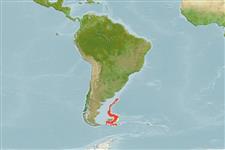Teleostei (teleosts) >
Gadiformes (Cods) >
Macrouridae (Grenadiers or rattails)
Etymology: Macrourus: Greek, makroura = great tail (Ref. 45335).
More on author: Günther.
Environment: milieu / climate zone / depth range / distribution range
Ecology
Marine; bathydemersal; depth range 300 - 1400 m. Deep-water; 39°S - 57°S, 62°W - 38°W (Ref. 1371)
Southwest Atlantic: so far known only from the Patagonian slope from east of the Rio de la Plata to north of the Falkland Islands and off Shag Rock west of South Georgia. It can be expected also on the west coast of Chile, but its presence there, as well as in other regions where it has been reported must be confirmed.
Size / Weight / Age
Maturity: Lm ? range ? - ? cm
Max length : 80.0 cm TL male/unsexed; (Ref. 1371)
Life cycle and mating behavior
Maturities | Reproduction | Spawnings | Egg(s) | Fecundities | Larvae
Cohen, D.M., T. Inada, T. Iwamoto and N. Scialabba, 1990. FAO species catalogue. Vol. 10. Gadiform fishes of the world (Order Gadiformes). An annotated and illustrated catalogue of cods, hakes, grenadiers and other gadiform fishes known to date. FAO Fish. Synop. 125(10). Rome: FAO. 442 p. (Ref. 1371)
IUCN Red List Status (Ref. 130435)
Threat to humans
Harmless
Human uses
Fisheries: minor commercial
Tools
Special reports
Download XML
Internet sources
Estimates based on models
Preferred temperature (Ref.
123201): 2.8 - 4.4, mean 3.4 °C (based on 39 cells).
Phylogenetic diversity index (Ref.
82804): PD
50 = 0.5312 [Uniqueness, from 0.5 = low to 2.0 = high].
Bayesian length-weight: a=0.00191 (0.00124 - 0.00292), b=3.21 (3.08 - 3.34), in cm total length, based on LWR estimates for this species & (Sub)family-body (Ref.
93245).
Trophic level (Ref.
69278): 3.7 ±0.64 se; based on food items.
Resilience (Ref.
120179): Very Low, minimum population doubling time more than 14 years (Preliminary K or Fecundity.).
Fishing Vulnerability (Ref.
59153): Moderate to high vulnerability (52 of 100).
Climate Vulnerability (Ref.
125649): Moderate to high vulnerability (49 of 100).
Nutrients (Ref.
124155): Calcium = 17.8 [9.8, 39.5] mg/100g; Iron = 0.359 [0.180, 0.729] mg/100g; Protein = 16.8 [14.7, 18.9] %; Omega3 = 0.218 [0.100, 0.463] g/100g; Selenium = 26.8 [10.7, 60.5] μg/100g; VitaminA = 8.17 [1.71, 36.62] μg/100g; Zinc = 0.369 [0.242, 0.575] mg/100g (wet weight);
